Computer Security Engineering Report: Topics and Analysis
VerifiedAdded on 2020/02/24
|13
|3659
|429
Report
AI Summary
This report delves into various aspects of computer security engineering. It begins with an exploration of encryption techniques, differentiating between symmetric and public key encryption, and highlighting the significance of hashing functions for confidentiality and authentication, including password storage and data integrity checks. The report then examines secure networks, specifically addressing denial-of-service attacks and strategies for mitigation, such as traffic monitoring and risk mitigation plans. Furthermore, it covers access control, outlining rules for secure areas and methods to reduce unauthorized access to computer systems, including regular updates and the use of firewalls and intrusion detection systems. The report emphasizes the importance of these measures in protecting systems from potential threats and vulnerabilities. The provided content is a solved assignment, which can be found on Desklib, a platform that provides AI-based study tools and past papers to students.
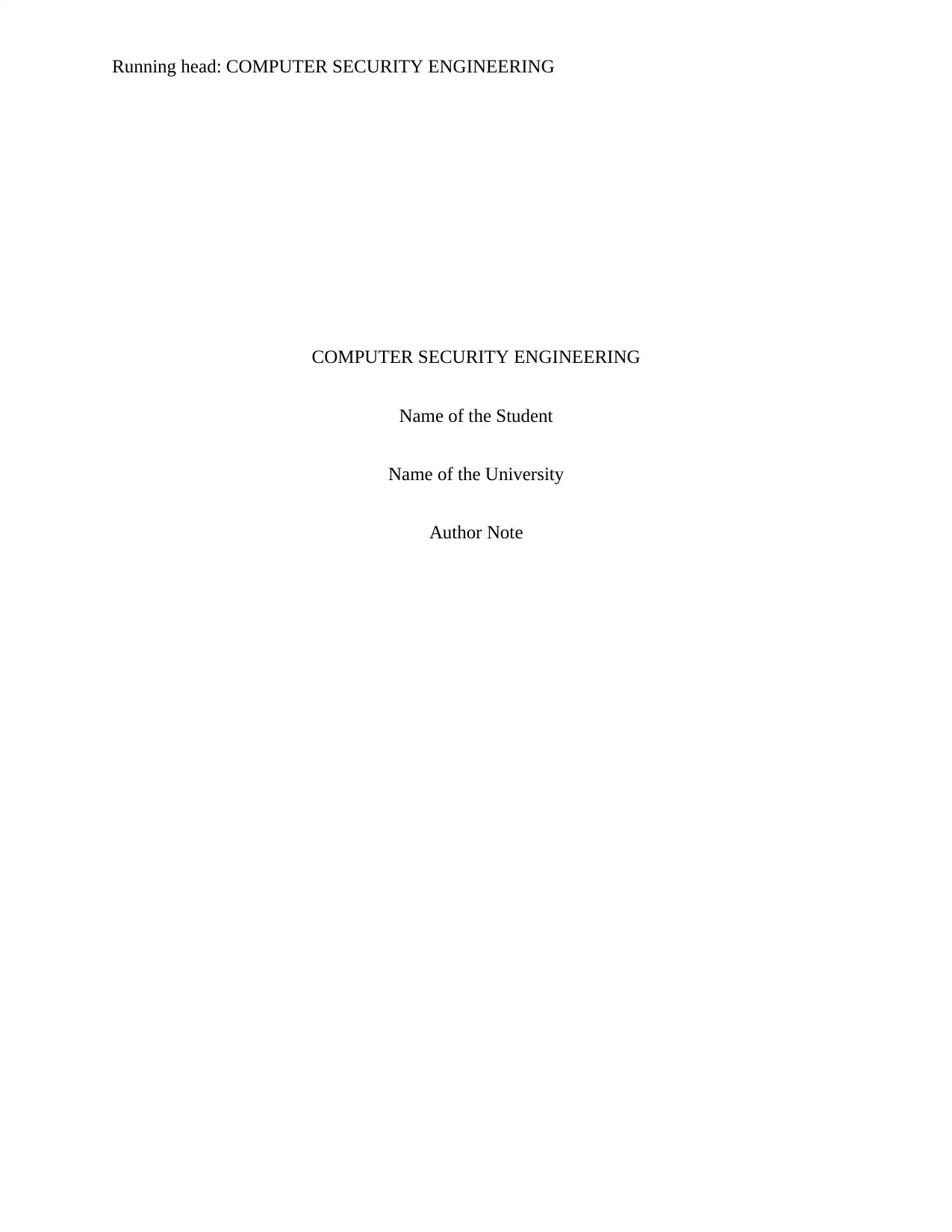
Running head: COMPUTER SECURITY ENGINEERING
COMPUTER SECURITY ENGINEERING
Name of the Student
Name of the University
Author Note
COMPUTER SECURITY ENGINEERING
Name of the Student
Name of the University
Author Note
Paraphrase This Document
Need a fresh take? Get an instant paraphrase of this document with our AI Paraphraser
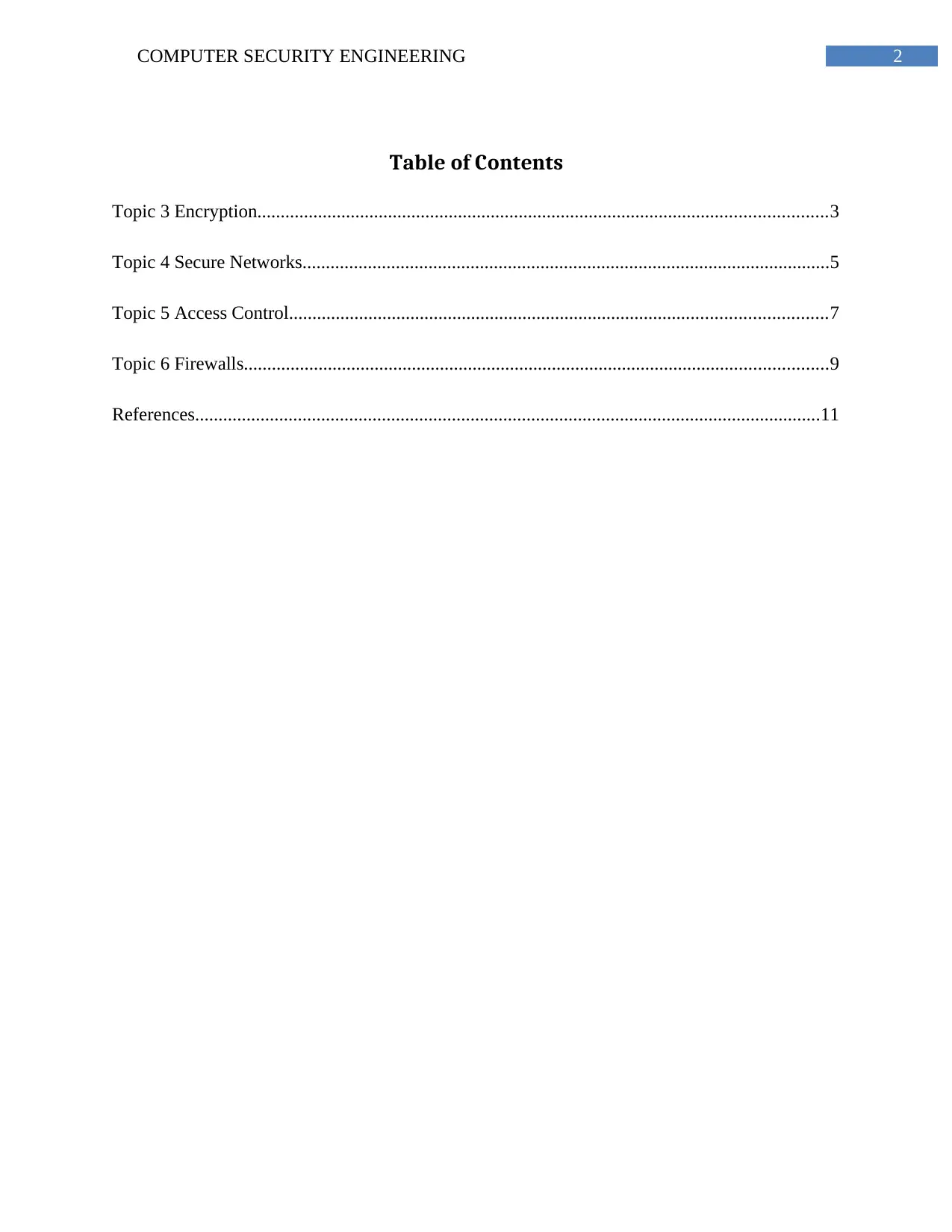
2COMPUTER SECURITY ENGINEERING
Table of Contents
Topic 3 Encryption..........................................................................................................................3
Topic 4 Secure Networks.................................................................................................................5
Topic 5 Access Control...................................................................................................................7
Topic 6 Firewalls.............................................................................................................................9
References......................................................................................................................................11
Table of Contents
Topic 3 Encryption..........................................................................................................................3
Topic 4 Secure Networks.................................................................................................................5
Topic 5 Access Control...................................................................................................................7
Topic 6 Firewalls.............................................................................................................................9
References......................................................................................................................................11
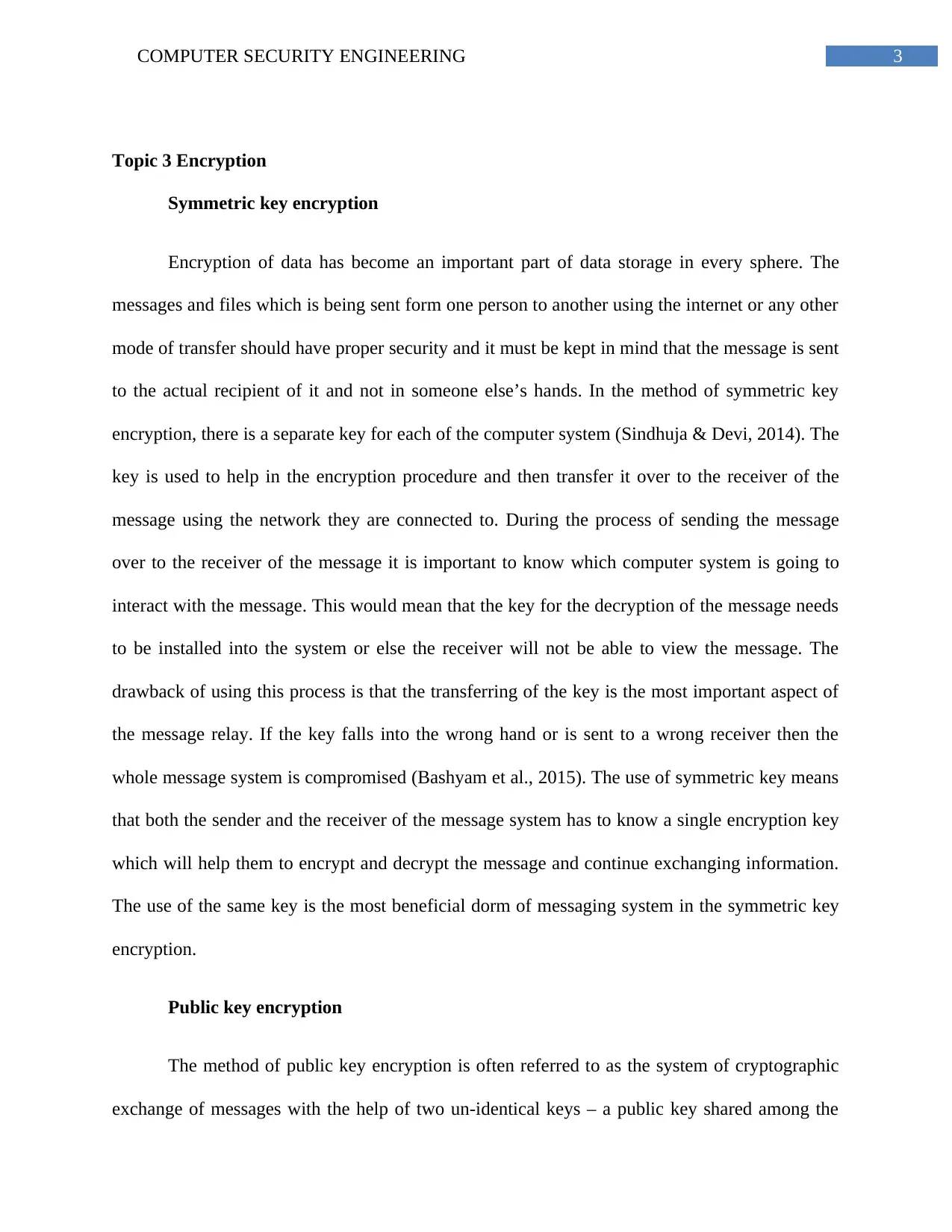
3COMPUTER SECURITY ENGINEERING
Topic 3 Encryption
Symmetric key encryption
Encryption of data has become an important part of data storage in every sphere. The
messages and files which is being sent form one person to another using the internet or any other
mode of transfer should have proper security and it must be kept in mind that the message is sent
to the actual recipient of it and not in someone else’s hands. In the method of symmetric key
encryption, there is a separate key for each of the computer system (Sindhuja & Devi, 2014). The
key is used to help in the encryption procedure and then transfer it over to the receiver of the
message using the network they are connected to. During the process of sending the message
over to the receiver of the message it is important to know which computer system is going to
interact with the message. This would mean that the key for the decryption of the message needs
to be installed into the system or else the receiver will not be able to view the message. The
drawback of using this process is that the transferring of the key is the most important aspect of
the message relay. If the key falls into the wrong hand or is sent to a wrong receiver then the
whole message system is compromised (Bashyam et al., 2015). The use of symmetric key means
that both the sender and the receiver of the message system has to know a single encryption key
which will help them to encrypt and decrypt the message and continue exchanging information.
The use of the same key is the most beneficial dorm of messaging system in the symmetric key
encryption.
Public key encryption
The method of public key encryption is often referred to as the system of cryptographic
exchange of messages with the help of two un-identical keys – a public key shared among the
Topic 3 Encryption
Symmetric key encryption
Encryption of data has become an important part of data storage in every sphere. The
messages and files which is being sent form one person to another using the internet or any other
mode of transfer should have proper security and it must be kept in mind that the message is sent
to the actual recipient of it and not in someone else’s hands. In the method of symmetric key
encryption, there is a separate key for each of the computer system (Sindhuja & Devi, 2014). The
key is used to help in the encryption procedure and then transfer it over to the receiver of the
message using the network they are connected to. During the process of sending the message
over to the receiver of the message it is important to know which computer system is going to
interact with the message. This would mean that the key for the decryption of the message needs
to be installed into the system or else the receiver will not be able to view the message. The
drawback of using this process is that the transferring of the key is the most important aspect of
the message relay. If the key falls into the wrong hand or is sent to a wrong receiver then the
whole message system is compromised (Bashyam et al., 2015). The use of symmetric key means
that both the sender and the receiver of the message system has to know a single encryption key
which will help them to encrypt and decrypt the message and continue exchanging information.
The use of the same key is the most beneficial dorm of messaging system in the symmetric key
encryption.
Public key encryption
The method of public key encryption is often referred to as the system of cryptographic
exchange of messages with the help of two un-identical keys – a public key shared among the
⊘ This is a preview!⊘
Do you want full access?
Subscribe today to unlock all pages.

Trusted by 1+ million students worldwide
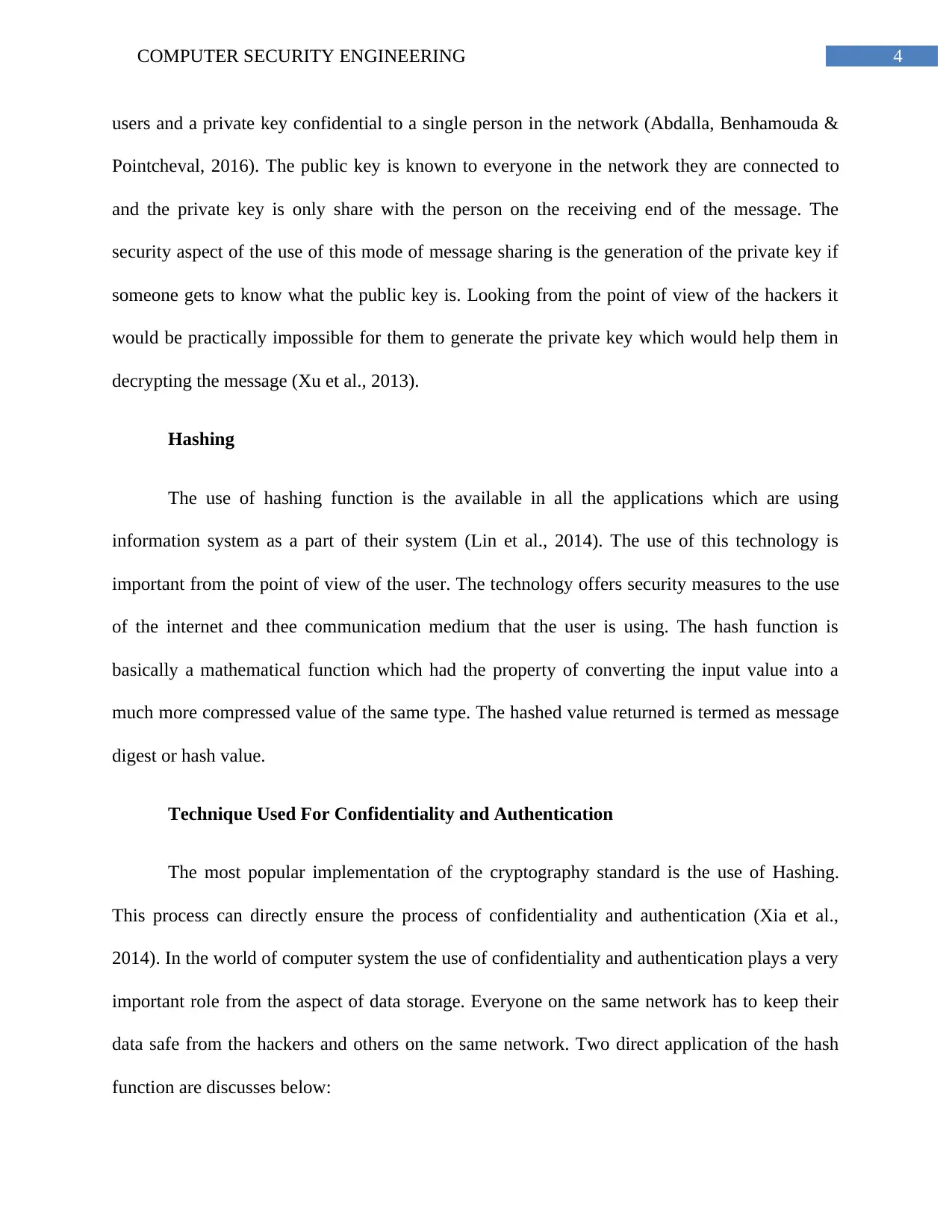
4COMPUTER SECURITY ENGINEERING
users and a private key confidential to a single person in the network (Abdalla, Benhamouda &
Pointcheval, 2016). The public key is known to everyone in the network they are connected to
and the private key is only share with the person on the receiving end of the message. The
security aspect of the use of this mode of message sharing is the generation of the private key if
someone gets to know what the public key is. Looking from the point of view of the hackers it
would be practically impossible for them to generate the private key which would help them in
decrypting the message (Xu et al., 2013).
Hashing
The use of hashing function is the available in all the applications which are using
information system as a part of their system (Lin et al., 2014). The use of this technology is
important from the point of view of the user. The technology offers security measures to the use
of the internet and thee communication medium that the user is using. The hash function is
basically a mathematical function which had the property of converting the input value into a
much more compressed value of the same type. The hashed value returned is termed as message
digest or hash value.
Technique Used For Confidentiality and Authentication
The most popular implementation of the cryptography standard is the use of Hashing.
This process can directly ensure the process of confidentiality and authentication (Xia et al.,
2014). In the world of computer system the use of confidentiality and authentication plays a very
important role from the aspect of data storage. Everyone on the same network has to keep their
data safe from the hackers and others on the same network. Two direct application of the hash
function are discusses below:
users and a private key confidential to a single person in the network (Abdalla, Benhamouda &
Pointcheval, 2016). The public key is known to everyone in the network they are connected to
and the private key is only share with the person on the receiving end of the message. The
security aspect of the use of this mode of message sharing is the generation of the private key if
someone gets to know what the public key is. Looking from the point of view of the hackers it
would be practically impossible for them to generate the private key which would help them in
decrypting the message (Xu et al., 2013).
Hashing
The use of hashing function is the available in all the applications which are using
information system as a part of their system (Lin et al., 2014). The use of this technology is
important from the point of view of the user. The technology offers security measures to the use
of the internet and thee communication medium that the user is using. The hash function is
basically a mathematical function which had the property of converting the input value into a
much more compressed value of the same type. The hashed value returned is termed as message
digest or hash value.
Technique Used For Confidentiality and Authentication
The most popular implementation of the cryptography standard is the use of Hashing.
This process can directly ensure the process of confidentiality and authentication (Xia et al.,
2014). In the world of computer system the use of confidentiality and authentication plays a very
important role from the aspect of data storage. Everyone on the same network has to keep their
data safe from the hackers and others on the same network. Two direct application of the hash
function are discusses below:
Paraphrase This Document
Need a fresh take? Get an instant paraphrase of this document with our AI Paraphraser
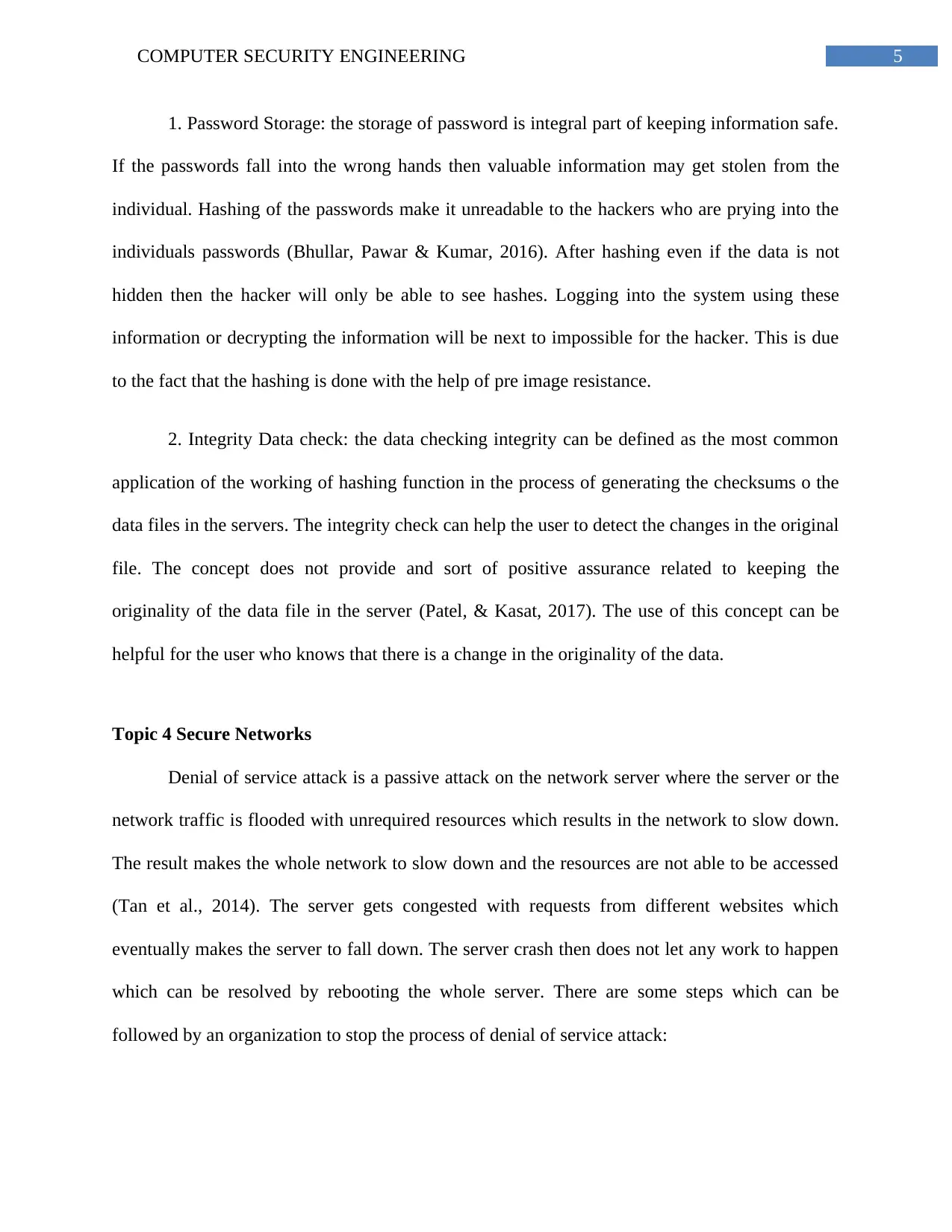
5COMPUTER SECURITY ENGINEERING
1. Password Storage: the storage of password is integral part of keeping information safe.
If the passwords fall into the wrong hands then valuable information may get stolen from the
individual. Hashing of the passwords make it unreadable to the hackers who are prying into the
individuals passwords (Bhullar, Pawar & Kumar, 2016). After hashing even if the data is not
hidden then the hacker will only be able to see hashes. Logging into the system using these
information or decrypting the information will be next to impossible for the hacker. This is due
to the fact that the hashing is done with the help of pre image resistance.
2. Integrity Data check: the data checking integrity can be defined as the most common
application of the working of hashing function in the process of generating the checksums o the
data files in the servers. The integrity check can help the user to detect the changes in the original
file. The concept does not provide and sort of positive assurance related to keeping the
originality of the data file in the server (Patel, & Kasat, 2017). The use of this concept can be
helpful for the user who knows that there is a change in the originality of the data.
Topic 4 Secure Networks
Denial of service attack is a passive attack on the network server where the server or the
network traffic is flooded with unrequired resources which results in the network to slow down.
The result makes the whole network to slow down and the resources are not able to be accessed
(Tan et al., 2014). The server gets congested with requests from different websites which
eventually makes the server to fall down. The server crash then does not let any work to happen
which can be resolved by rebooting the whole server. There are some steps which can be
followed by an organization to stop the process of denial of service attack:
1. Password Storage: the storage of password is integral part of keeping information safe.
If the passwords fall into the wrong hands then valuable information may get stolen from the
individual. Hashing of the passwords make it unreadable to the hackers who are prying into the
individuals passwords (Bhullar, Pawar & Kumar, 2016). After hashing even if the data is not
hidden then the hacker will only be able to see hashes. Logging into the system using these
information or decrypting the information will be next to impossible for the hacker. This is due
to the fact that the hashing is done with the help of pre image resistance.
2. Integrity Data check: the data checking integrity can be defined as the most common
application of the working of hashing function in the process of generating the checksums o the
data files in the servers. The integrity check can help the user to detect the changes in the original
file. The concept does not provide and sort of positive assurance related to keeping the
originality of the data file in the server (Patel, & Kasat, 2017). The use of this concept can be
helpful for the user who knows that there is a change in the originality of the data.
Topic 4 Secure Networks
Denial of service attack is a passive attack on the network server where the server or the
network traffic is flooded with unrequired resources which results in the network to slow down.
The result makes the whole network to slow down and the resources are not able to be accessed
(Tan et al., 2014). The server gets congested with requests from different websites which
eventually makes the server to fall down. The server crash then does not let any work to happen
which can be resolved by rebooting the whole server. There are some steps which can be
followed by an organization to stop the process of denial of service attack:
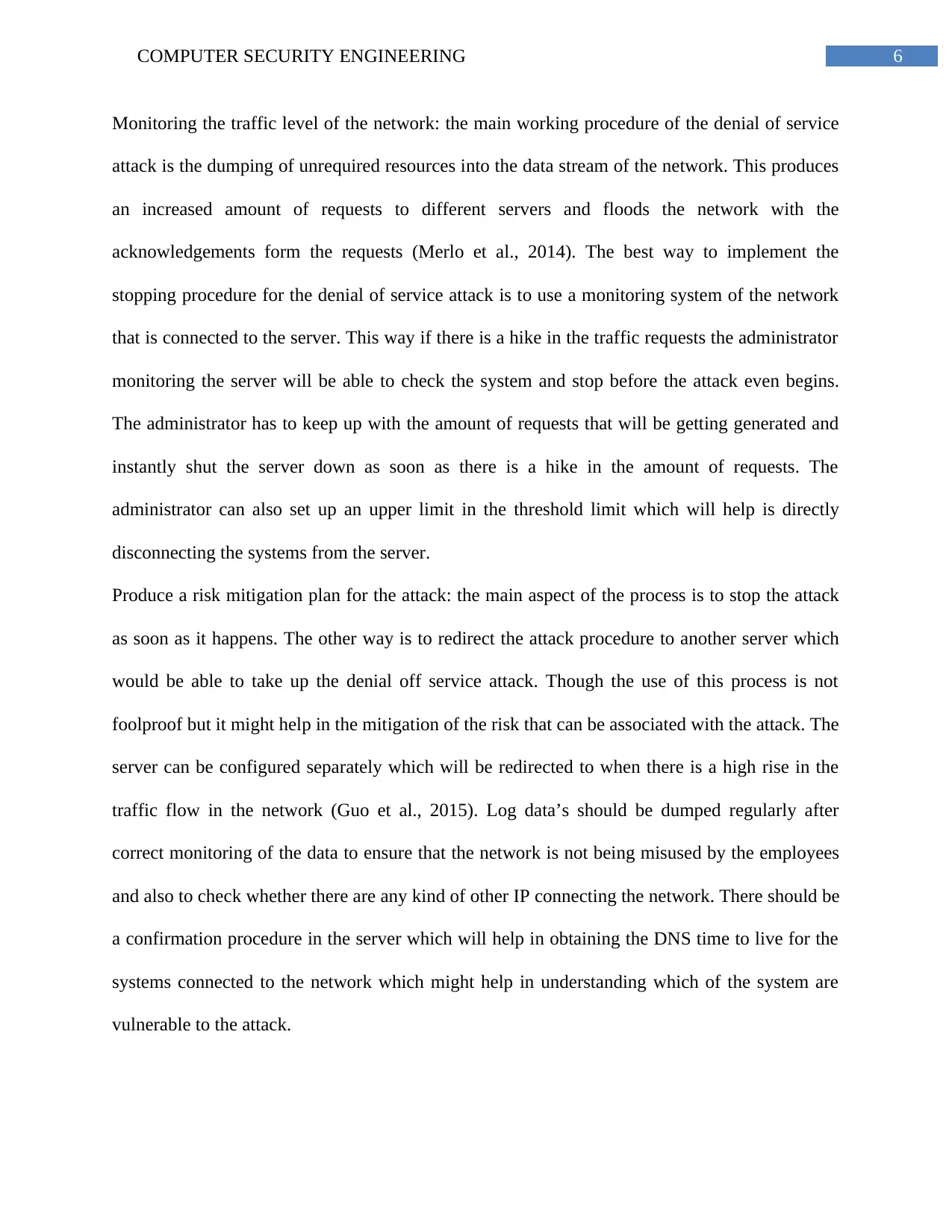
6COMPUTER SECURITY ENGINEERING
Monitoring the traffic level of the network: the main working procedure of the denial of service
attack is the dumping of unrequired resources into the data stream of the network. This produces
an increased amount of requests to different servers and floods the network with the
acknowledgements form the requests (Merlo et al., 2014). The best way to implement the
stopping procedure for the denial of service attack is to use a monitoring system of the network
that is connected to the server. This way if there is a hike in the traffic requests the administrator
monitoring the server will be able to check the system and stop before the attack even begins.
The administrator has to keep up with the amount of requests that will be getting generated and
instantly shut the server down as soon as there is a hike in the amount of requests. The
administrator can also set up an upper limit in the threshold limit which will help is directly
disconnecting the systems from the server.
Produce a risk mitigation plan for the attack: the main aspect of the process is to stop the attack
as soon as it happens. The other way is to redirect the attack procedure to another server which
would be able to take up the denial off service attack. Though the use of this process is not
foolproof but it might help in the mitigation of the risk that can be associated with the attack. The
server can be configured separately which will be redirected to when there is a high rise in the
traffic flow in the network (Guo et al., 2015). Log data’s should be dumped regularly after
correct monitoring of the data to ensure that the network is not being misused by the employees
and also to check whether there are any kind of other IP connecting the network. There should be
a confirmation procedure in the server which will help in obtaining the DNS time to live for the
systems connected to the network which might help in understanding which of the system are
vulnerable to the attack.
Monitoring the traffic level of the network: the main working procedure of the denial of service
attack is the dumping of unrequired resources into the data stream of the network. This produces
an increased amount of requests to different servers and floods the network with the
acknowledgements form the requests (Merlo et al., 2014). The best way to implement the
stopping procedure for the denial of service attack is to use a monitoring system of the network
that is connected to the server. This way if there is a hike in the traffic requests the administrator
monitoring the server will be able to check the system and stop before the attack even begins.
The administrator has to keep up with the amount of requests that will be getting generated and
instantly shut the server down as soon as there is a hike in the amount of requests. The
administrator can also set up an upper limit in the threshold limit which will help is directly
disconnecting the systems from the server.
Produce a risk mitigation plan for the attack: the main aspect of the process is to stop the attack
as soon as it happens. The other way is to redirect the attack procedure to another server which
would be able to take up the denial off service attack. Though the use of this process is not
foolproof but it might help in the mitigation of the risk that can be associated with the attack. The
server can be configured separately which will be redirected to when there is a high rise in the
traffic flow in the network (Guo et al., 2015). Log data’s should be dumped regularly after
correct monitoring of the data to ensure that the network is not being misused by the employees
and also to check whether there are any kind of other IP connecting the network. There should be
a confirmation procedure in the server which will help in obtaining the DNS time to live for the
systems connected to the network which might help in understanding which of the system are
vulnerable to the attack.
⊘ This is a preview!⊘
Do you want full access?
Subscribe today to unlock all pages.

Trusted by 1+ million students worldwide
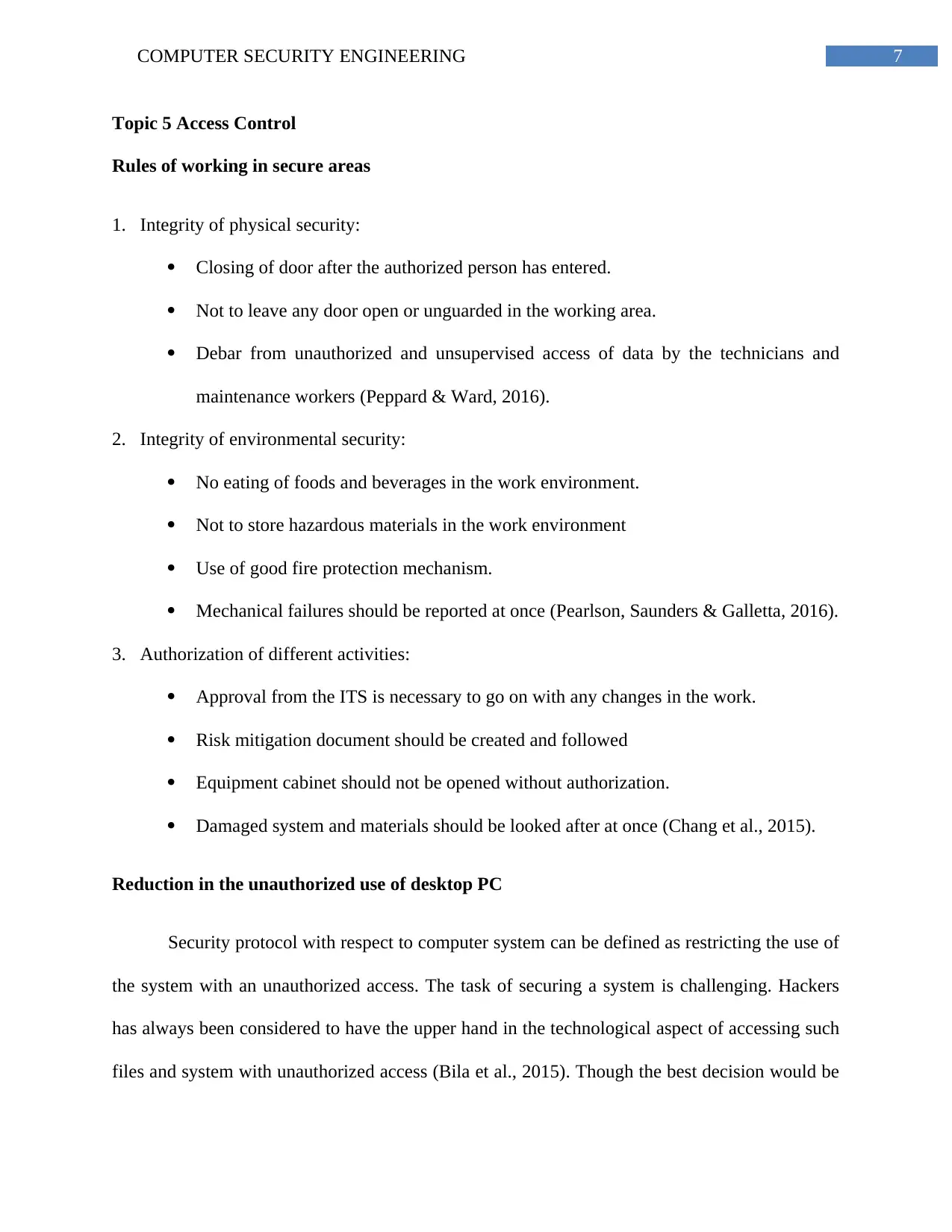
7COMPUTER SECURITY ENGINEERING
Topic 5 Access Control
Rules of working in secure areas
1. Integrity of physical security:
Closing of door after the authorized person has entered.
Not to leave any door open or unguarded in the working area.
Debar from unauthorized and unsupervised access of data by the technicians and
maintenance workers (Peppard & Ward, 2016).
2. Integrity of environmental security:
No eating of foods and beverages in the work environment.
Not to store hazardous materials in the work environment
Use of good fire protection mechanism.
Mechanical failures should be reported at once (Pearlson, Saunders & Galletta, 2016).
3. Authorization of different activities:
Approval from the ITS is necessary to go on with any changes in the work.
Risk mitigation document should be created and followed
Equipment cabinet should not be opened without authorization.
Damaged system and materials should be looked after at once (Chang et al., 2015).
Reduction in the unauthorized use of desktop PC
Security protocol with respect to computer system can be defined as restricting the use of
the system with an unauthorized access. The task of securing a system is challenging. Hackers
has always been considered to have the upper hand in the technological aspect of accessing such
files and system with unauthorized access (Bila et al., 2015). Though the best decision would be
Topic 5 Access Control
Rules of working in secure areas
1. Integrity of physical security:
Closing of door after the authorized person has entered.
Not to leave any door open or unguarded in the working area.
Debar from unauthorized and unsupervised access of data by the technicians and
maintenance workers (Peppard & Ward, 2016).
2. Integrity of environmental security:
No eating of foods and beverages in the work environment.
Not to store hazardous materials in the work environment
Use of good fire protection mechanism.
Mechanical failures should be reported at once (Pearlson, Saunders & Galletta, 2016).
3. Authorization of different activities:
Approval from the ITS is necessary to go on with any changes in the work.
Risk mitigation document should be created and followed
Equipment cabinet should not be opened without authorization.
Damaged system and materials should be looked after at once (Chang et al., 2015).
Reduction in the unauthorized use of desktop PC
Security protocol with respect to computer system can be defined as restricting the use of
the system with an unauthorized access. The task of securing a system is challenging. Hackers
has always been considered to have the upper hand in the technological aspect of accessing such
files and system with unauthorized access (Bila et al., 2015). Though the best decision would be
Paraphrase This Document
Need a fresh take? Get an instant paraphrase of this document with our AI Paraphraser
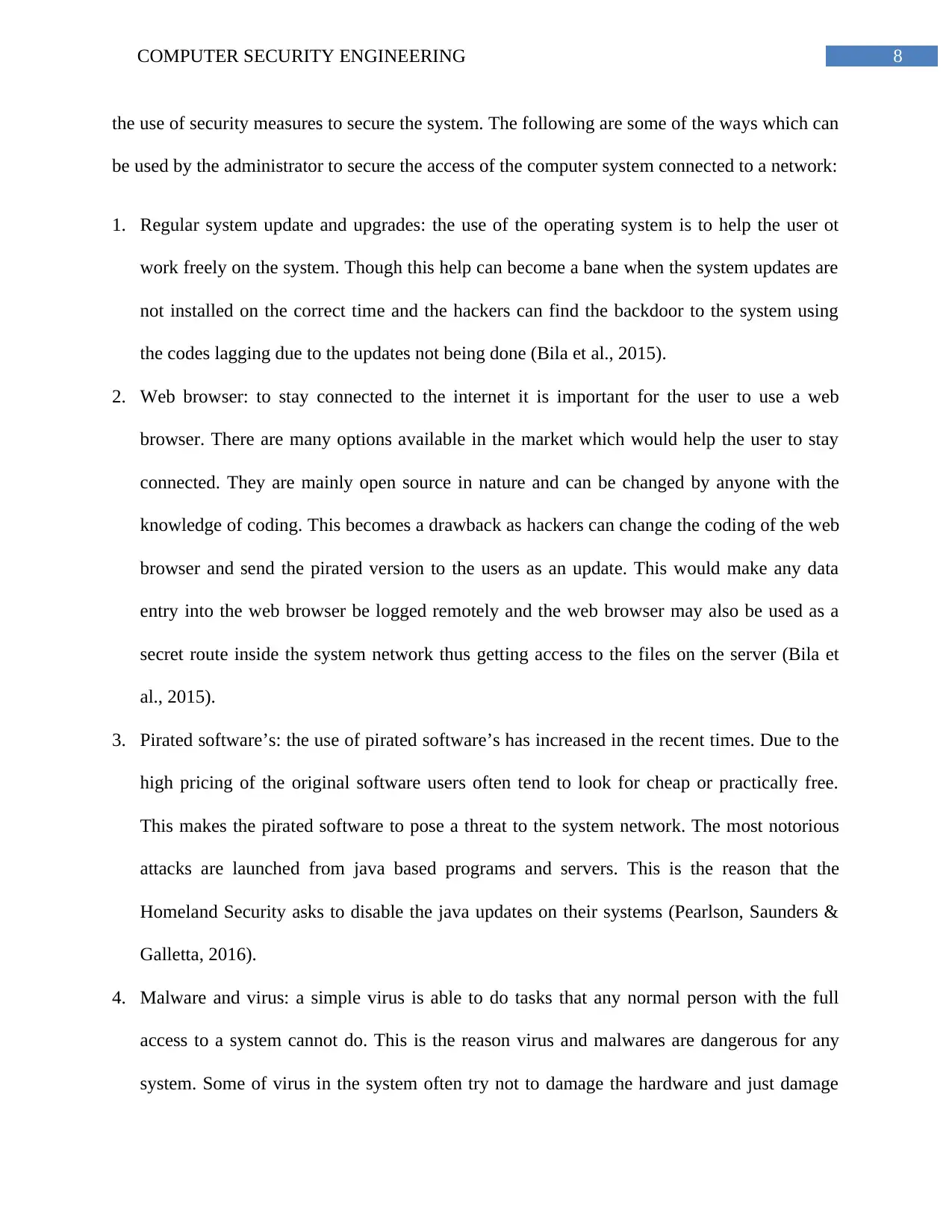
8COMPUTER SECURITY ENGINEERING
the use of security measures to secure the system. The following are some of the ways which can
be used by the administrator to secure the access of the computer system connected to a network:
1. Regular system update and upgrades: the use of the operating system is to help the user ot
work freely on the system. Though this help can become a bane when the system updates are
not installed on the correct time and the hackers can find the backdoor to the system using
the codes lagging due to the updates not being done (Bila et al., 2015).
2. Web browser: to stay connected to the internet it is important for the user to use a web
browser. There are many options available in the market which would help the user to stay
connected. They are mainly open source in nature and can be changed by anyone with the
knowledge of coding. This becomes a drawback as hackers can change the coding of the web
browser and send the pirated version to the users as an update. This would make any data
entry into the web browser be logged remotely and the web browser may also be used as a
secret route inside the system network thus getting access to the files on the server (Bila et
al., 2015).
3. Pirated software’s: the use of pirated software’s has increased in the recent times. Due to the
high pricing of the original software users often tend to look for cheap or practically free.
This makes the pirated software to pose a threat to the system network. The most notorious
attacks are launched from java based programs and servers. This is the reason that the
Homeland Security asks to disable the java updates on their systems (Pearlson, Saunders &
Galletta, 2016).
4. Malware and virus: a simple virus is able to do tasks that any normal person with the full
access to a system cannot do. This is the reason virus and malwares are dangerous for any
system. Some of virus in the system often try not to damage the hardware and just damage
the use of security measures to secure the system. The following are some of the ways which can
be used by the administrator to secure the access of the computer system connected to a network:
1. Regular system update and upgrades: the use of the operating system is to help the user ot
work freely on the system. Though this help can become a bane when the system updates are
not installed on the correct time and the hackers can find the backdoor to the system using
the codes lagging due to the updates not being done (Bila et al., 2015).
2. Web browser: to stay connected to the internet it is important for the user to use a web
browser. There are many options available in the market which would help the user to stay
connected. They are mainly open source in nature and can be changed by anyone with the
knowledge of coding. This becomes a drawback as hackers can change the coding of the web
browser and send the pirated version to the users as an update. This would make any data
entry into the web browser be logged remotely and the web browser may also be used as a
secret route inside the system network thus getting access to the files on the server (Bila et
al., 2015).
3. Pirated software’s: the use of pirated software’s has increased in the recent times. Due to the
high pricing of the original software users often tend to look for cheap or practically free.
This makes the pirated software to pose a threat to the system network. The most notorious
attacks are launched from java based programs and servers. This is the reason that the
Homeland Security asks to disable the java updates on their systems (Pearlson, Saunders &
Galletta, 2016).
4. Malware and virus: a simple virus is able to do tasks that any normal person with the full
access to a system cannot do. This is the reason virus and malwares are dangerous for any
system. Some of virus in the system often try not to damage the hardware and just damage
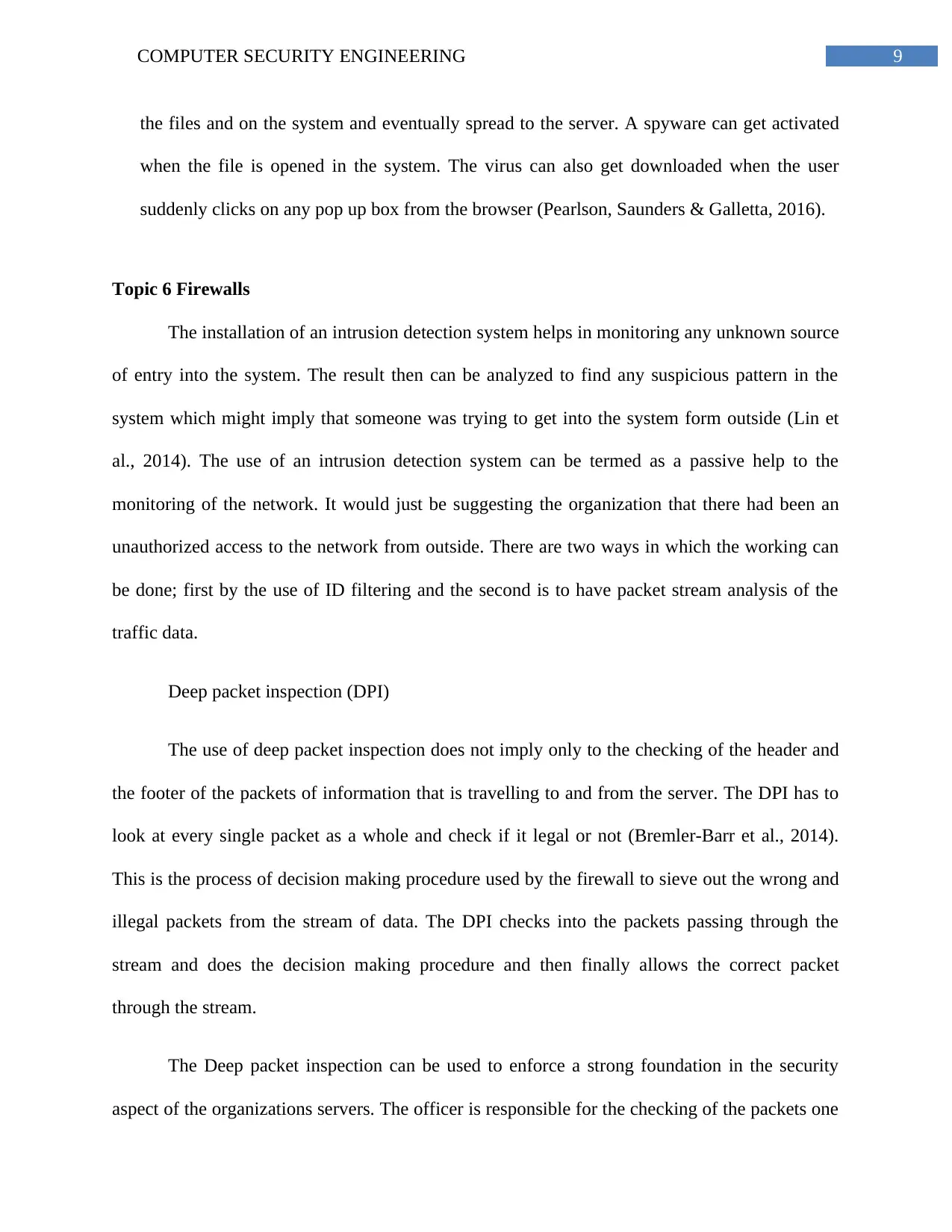
9COMPUTER SECURITY ENGINEERING
the files and on the system and eventually spread to the server. A spyware can get activated
when the file is opened in the system. The virus can also get downloaded when the user
suddenly clicks on any pop up box from the browser (Pearlson, Saunders & Galletta, 2016).
Topic 6 Firewalls
The installation of an intrusion detection system helps in monitoring any unknown source
of entry into the system. The result then can be analyzed to find any suspicious pattern in the
system which might imply that someone was trying to get into the system form outside (Lin et
al., 2014). The use of an intrusion detection system can be termed as a passive help to the
monitoring of the network. It would just be suggesting the organization that there had been an
unauthorized access to the network from outside. There are two ways in which the working can
be done; first by the use of ID filtering and the second is to have packet stream analysis of the
traffic data.
Deep packet inspection (DPI)
The use of deep packet inspection does not imply only to the checking of the header and
the footer of the packets of information that is travelling to and from the server. The DPI has to
look at every single packet as a whole and check if it legal or not (Bremler-Barr et al., 2014).
This is the process of decision making procedure used by the firewall to sieve out the wrong and
illegal packets from the stream of data. The DPI checks into the packets passing through the
stream and does the decision making procedure and then finally allows the correct packet
through the stream.
The Deep packet inspection can be used to enforce a strong foundation in the security
aspect of the organizations servers. The officer is responsible for the checking of the packets one
the files and on the system and eventually spread to the server. A spyware can get activated
when the file is opened in the system. The virus can also get downloaded when the user
suddenly clicks on any pop up box from the browser (Pearlson, Saunders & Galletta, 2016).
Topic 6 Firewalls
The installation of an intrusion detection system helps in monitoring any unknown source
of entry into the system. The result then can be analyzed to find any suspicious pattern in the
system which might imply that someone was trying to get into the system form outside (Lin et
al., 2014). The use of an intrusion detection system can be termed as a passive help to the
monitoring of the network. It would just be suggesting the organization that there had been an
unauthorized access to the network from outside. There are two ways in which the working can
be done; first by the use of ID filtering and the second is to have packet stream analysis of the
traffic data.
Deep packet inspection (DPI)
The use of deep packet inspection does not imply only to the checking of the header and
the footer of the packets of information that is travelling to and from the server. The DPI has to
look at every single packet as a whole and check if it legal or not (Bremler-Barr et al., 2014).
This is the process of decision making procedure used by the firewall to sieve out the wrong and
illegal packets from the stream of data. The DPI checks into the packets passing through the
stream and does the decision making procedure and then finally allows the correct packet
through the stream.
The Deep packet inspection can be used to enforce a strong foundation in the security
aspect of the organizations servers. The officer is responsible for the checking of the packets one
⊘ This is a preview!⊘
Do you want full access?
Subscribe today to unlock all pages.

Trusted by 1+ million students worldwide
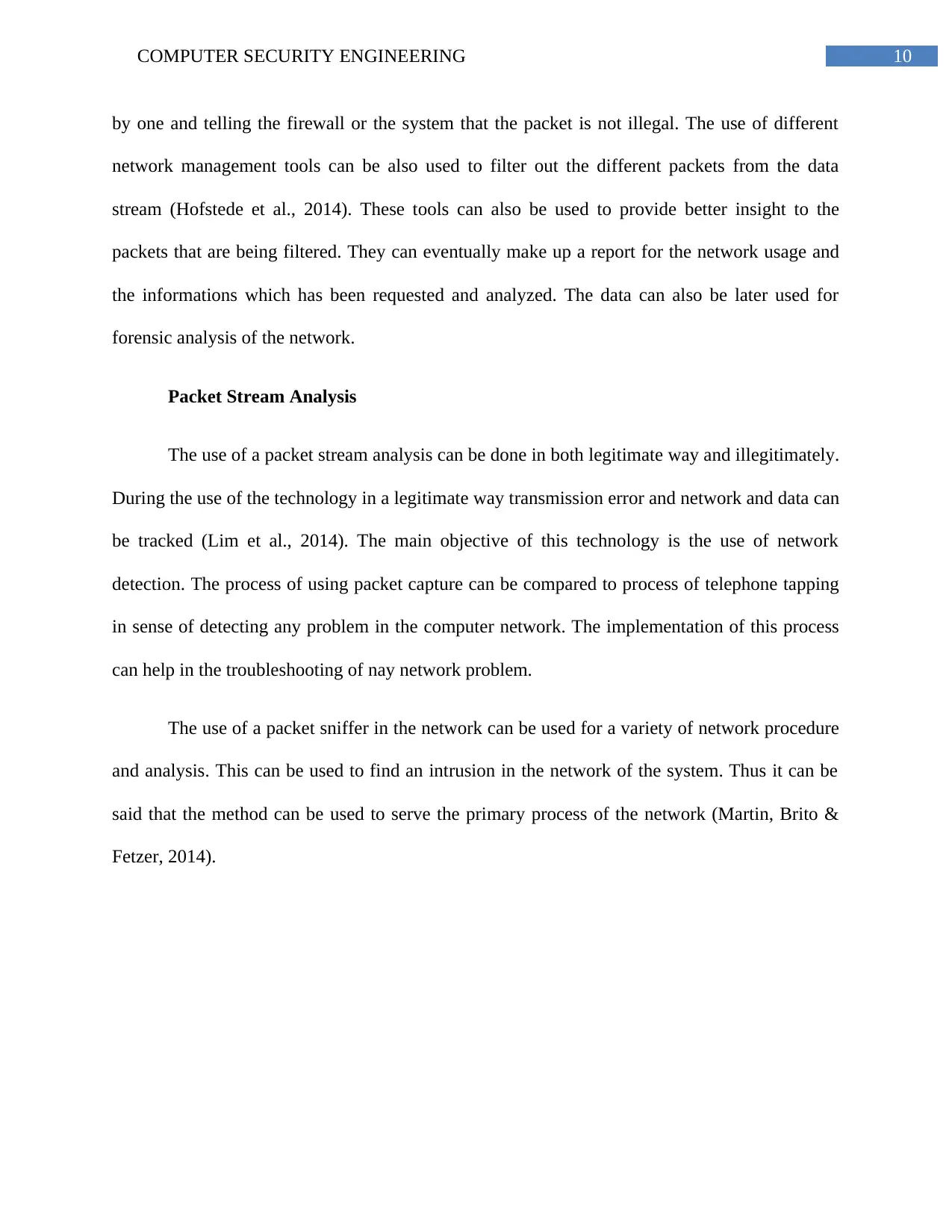
10COMPUTER SECURITY ENGINEERING
by one and telling the firewall or the system that the packet is not illegal. The use of different
network management tools can be also used to filter out the different packets from the data
stream (Hofstede et al., 2014). These tools can also be used to provide better insight to the
packets that are being filtered. They can eventually make up a report for the network usage and
the informations which has been requested and analyzed. The data can also be later used for
forensic analysis of the network.
Packet Stream Analysis
The use of a packet stream analysis can be done in both legitimate way and illegitimately.
During the use of the technology in a legitimate way transmission error and network and data can
be tracked (Lim et al., 2014). The main objective of this technology is the use of network
detection. The process of using packet capture can be compared to process of telephone tapping
in sense of detecting any problem in the computer network. The implementation of this process
can help in the troubleshooting of nay network problem.
The use of a packet sniffer in the network can be used for a variety of network procedure
and analysis. This can be used to find an intrusion in the network of the system. Thus it can be
said that the method can be used to serve the primary process of the network (Martin, Brito &
Fetzer, 2014).
by one and telling the firewall or the system that the packet is not illegal. The use of different
network management tools can be also used to filter out the different packets from the data
stream (Hofstede et al., 2014). These tools can also be used to provide better insight to the
packets that are being filtered. They can eventually make up a report for the network usage and
the informations which has been requested and analyzed. The data can also be later used for
forensic analysis of the network.
Packet Stream Analysis
The use of a packet stream analysis can be done in both legitimate way and illegitimately.
During the use of the technology in a legitimate way transmission error and network and data can
be tracked (Lim et al., 2014). The main objective of this technology is the use of network
detection. The process of using packet capture can be compared to process of telephone tapping
in sense of detecting any problem in the computer network. The implementation of this process
can help in the troubleshooting of nay network problem.
The use of a packet sniffer in the network can be used for a variety of network procedure
and analysis. This can be used to find an intrusion in the network of the system. Thus it can be
said that the method can be used to serve the primary process of the network (Martin, Brito &
Fetzer, 2014).
Paraphrase This Document
Need a fresh take? Get an instant paraphrase of this document with our AI Paraphraser
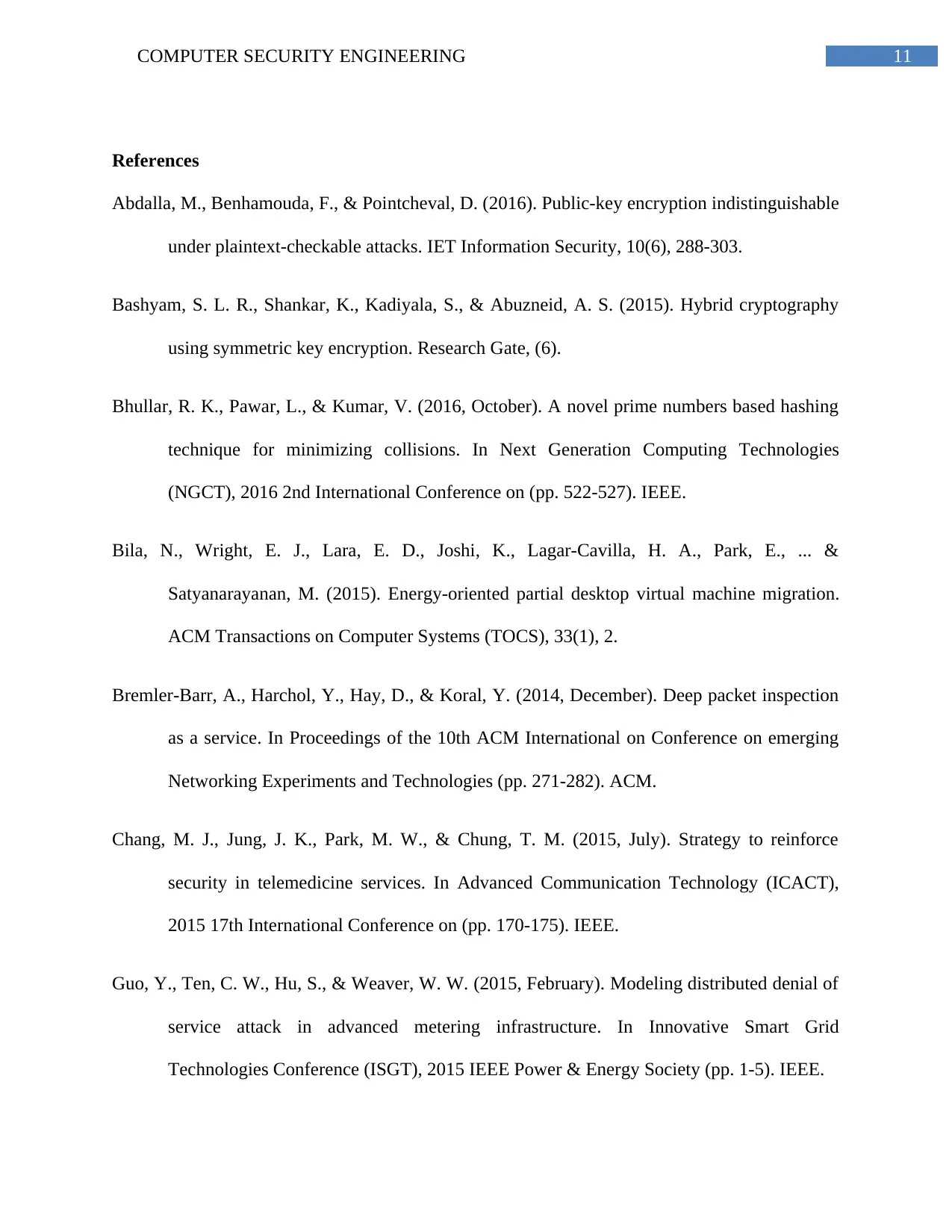
11COMPUTER SECURITY ENGINEERING
References
Abdalla, M., Benhamouda, F., & Pointcheval, D. (2016). Public-key encryption indistinguishable
under plaintext-checkable attacks. IET Information Security, 10(6), 288-303.
Bashyam, S. L. R., Shankar, K., Kadiyala, S., & Abuzneid, A. S. (2015). Hybrid cryptography
using symmetric key encryption. Research Gate, (6).
Bhullar, R. K., Pawar, L., & Kumar, V. (2016, October). A novel prime numbers based hashing
technique for minimizing collisions. In Next Generation Computing Technologies
(NGCT), 2016 2nd International Conference on (pp. 522-527). IEEE.
Bila, N., Wright, E. J., Lara, E. D., Joshi, K., Lagar-Cavilla, H. A., Park, E., ... &
Satyanarayanan, M. (2015). Energy-oriented partial desktop virtual machine migration.
ACM Transactions on Computer Systems (TOCS), 33(1), 2.
Bremler-Barr, A., Harchol, Y., Hay, D., & Koral, Y. (2014, December). Deep packet inspection
as a service. In Proceedings of the 10th ACM International on Conference on emerging
Networking Experiments and Technologies (pp. 271-282). ACM.
Chang, M. J., Jung, J. K., Park, M. W., & Chung, T. M. (2015, July). Strategy to reinforce
security in telemedicine services. In Advanced Communication Technology (ICACT),
2015 17th International Conference on (pp. 170-175). IEEE.
Guo, Y., Ten, C. W., Hu, S., & Weaver, W. W. (2015, February). Modeling distributed denial of
service attack in advanced metering infrastructure. In Innovative Smart Grid
Technologies Conference (ISGT), 2015 IEEE Power & Energy Society (pp. 1-5). IEEE.
References
Abdalla, M., Benhamouda, F., & Pointcheval, D. (2016). Public-key encryption indistinguishable
under plaintext-checkable attacks. IET Information Security, 10(6), 288-303.
Bashyam, S. L. R., Shankar, K., Kadiyala, S., & Abuzneid, A. S. (2015). Hybrid cryptography
using symmetric key encryption. Research Gate, (6).
Bhullar, R. K., Pawar, L., & Kumar, V. (2016, October). A novel prime numbers based hashing
technique for minimizing collisions. In Next Generation Computing Technologies
(NGCT), 2016 2nd International Conference on (pp. 522-527). IEEE.
Bila, N., Wright, E. J., Lara, E. D., Joshi, K., Lagar-Cavilla, H. A., Park, E., ... &
Satyanarayanan, M. (2015). Energy-oriented partial desktop virtual machine migration.
ACM Transactions on Computer Systems (TOCS), 33(1), 2.
Bremler-Barr, A., Harchol, Y., Hay, D., & Koral, Y. (2014, December). Deep packet inspection
as a service. In Proceedings of the 10th ACM International on Conference on emerging
Networking Experiments and Technologies (pp. 271-282). ACM.
Chang, M. J., Jung, J. K., Park, M. W., & Chung, T. M. (2015, July). Strategy to reinforce
security in telemedicine services. In Advanced Communication Technology (ICACT),
2015 17th International Conference on (pp. 170-175). IEEE.
Guo, Y., Ten, C. W., Hu, S., & Weaver, W. W. (2015, February). Modeling distributed denial of
service attack in advanced metering infrastructure. In Innovative Smart Grid
Technologies Conference (ISGT), 2015 IEEE Power & Energy Society (pp. 1-5). IEEE.
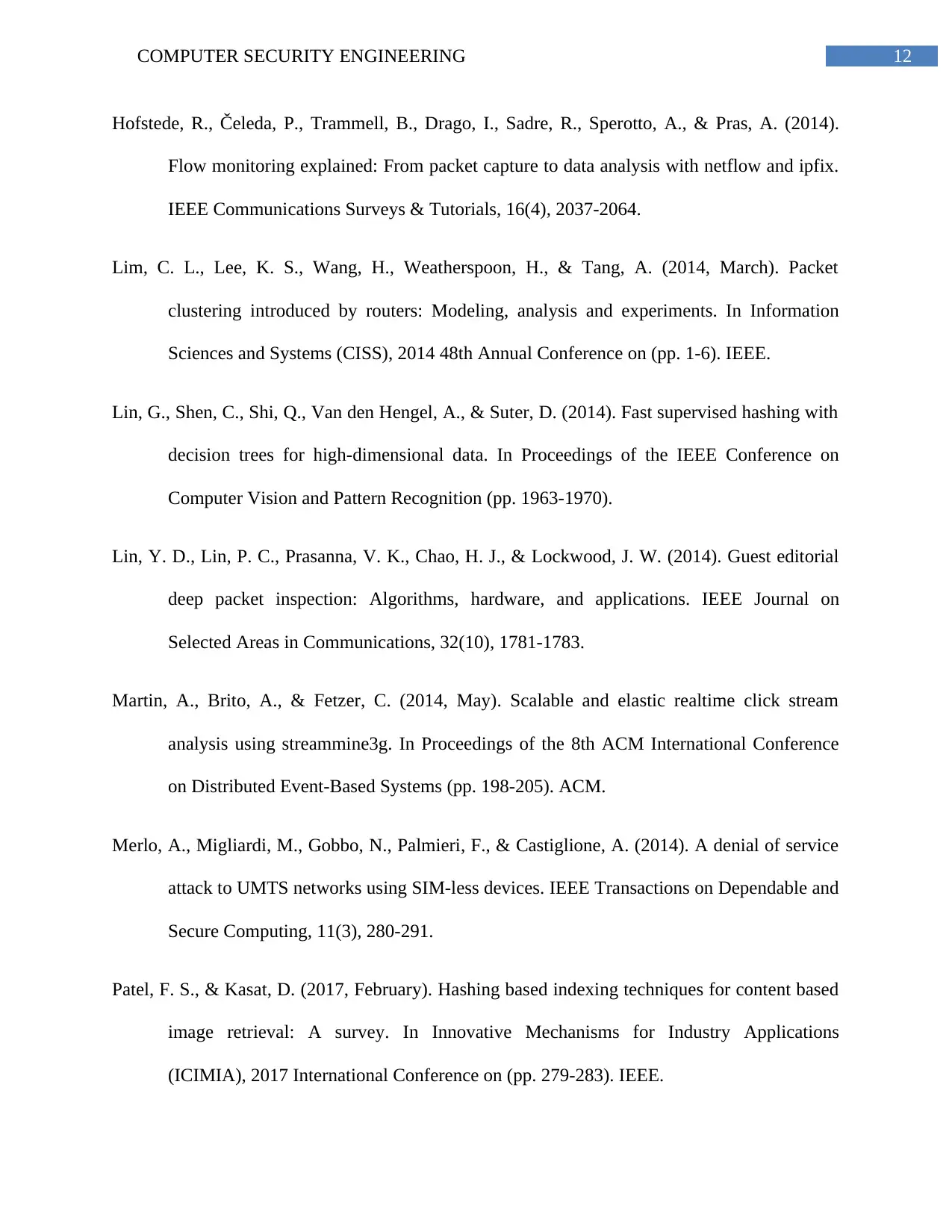
12COMPUTER SECURITY ENGINEERING
Hofstede, R., Čeleda, P., Trammell, B., Drago, I., Sadre, R., Sperotto, A., & Pras, A. (2014).
Flow monitoring explained: From packet capture to data analysis with netflow and ipfix.
IEEE Communications Surveys & Tutorials, 16(4), 2037-2064.
Lim, C. L., Lee, K. S., Wang, H., Weatherspoon, H., & Tang, A. (2014, March). Packet
clustering introduced by routers: Modeling, analysis and experiments. In Information
Sciences and Systems (CISS), 2014 48th Annual Conference on (pp. 1-6). IEEE.
Lin, G., Shen, C., Shi, Q., Van den Hengel, A., & Suter, D. (2014). Fast supervised hashing with
decision trees for high-dimensional data. In Proceedings of the IEEE Conference on
Computer Vision and Pattern Recognition (pp. 1963-1970).
Lin, Y. D., Lin, P. C., Prasanna, V. K., Chao, H. J., & Lockwood, J. W. (2014). Guest editorial
deep packet inspection: Algorithms, hardware, and applications. IEEE Journal on
Selected Areas in Communications, 32(10), 1781-1783.
Martin, A., Brito, A., & Fetzer, C. (2014, May). Scalable and elastic realtime click stream
analysis using streammine3g. In Proceedings of the 8th ACM International Conference
on Distributed Event-Based Systems (pp. 198-205). ACM.
Merlo, A., Migliardi, M., Gobbo, N., Palmieri, F., & Castiglione, A. (2014). A denial of service
attack to UMTS networks using SIM-less devices. IEEE Transactions on Dependable and
Secure Computing, 11(3), 280-291.
Patel, F. S., & Kasat, D. (2017, February). Hashing based indexing techniques for content based
image retrieval: A survey. In Innovative Mechanisms for Industry Applications
(ICIMIA), 2017 International Conference on (pp. 279-283). IEEE.
Hofstede, R., Čeleda, P., Trammell, B., Drago, I., Sadre, R., Sperotto, A., & Pras, A. (2014).
Flow monitoring explained: From packet capture to data analysis with netflow and ipfix.
IEEE Communications Surveys & Tutorials, 16(4), 2037-2064.
Lim, C. L., Lee, K. S., Wang, H., Weatherspoon, H., & Tang, A. (2014, March). Packet
clustering introduced by routers: Modeling, analysis and experiments. In Information
Sciences and Systems (CISS), 2014 48th Annual Conference on (pp. 1-6). IEEE.
Lin, G., Shen, C., Shi, Q., Van den Hengel, A., & Suter, D. (2014). Fast supervised hashing with
decision trees for high-dimensional data. In Proceedings of the IEEE Conference on
Computer Vision and Pattern Recognition (pp. 1963-1970).
Lin, Y. D., Lin, P. C., Prasanna, V. K., Chao, H. J., & Lockwood, J. W. (2014). Guest editorial
deep packet inspection: Algorithms, hardware, and applications. IEEE Journal on
Selected Areas in Communications, 32(10), 1781-1783.
Martin, A., Brito, A., & Fetzer, C. (2014, May). Scalable and elastic realtime click stream
analysis using streammine3g. In Proceedings of the 8th ACM International Conference
on Distributed Event-Based Systems (pp. 198-205). ACM.
Merlo, A., Migliardi, M., Gobbo, N., Palmieri, F., & Castiglione, A. (2014). A denial of service
attack to UMTS networks using SIM-less devices. IEEE Transactions on Dependable and
Secure Computing, 11(3), 280-291.
Patel, F. S., & Kasat, D. (2017, February). Hashing based indexing techniques for content based
image retrieval: A survey. In Innovative Mechanisms for Industry Applications
(ICIMIA), 2017 International Conference on (pp. 279-283). IEEE.
⊘ This is a preview!⊘
Do you want full access?
Subscribe today to unlock all pages.

Trusted by 1+ million students worldwide
1 out of 13
Related Documents
Your All-in-One AI-Powered Toolkit for Academic Success.
+13062052269
info@desklib.com
Available 24*7 on WhatsApp / Email
![[object Object]](/_next/static/media/star-bottom.7253800d.svg)
Unlock your academic potential
Copyright © 2020–2025 A2Z Services. All Rights Reserved. Developed and managed by ZUCOL.





